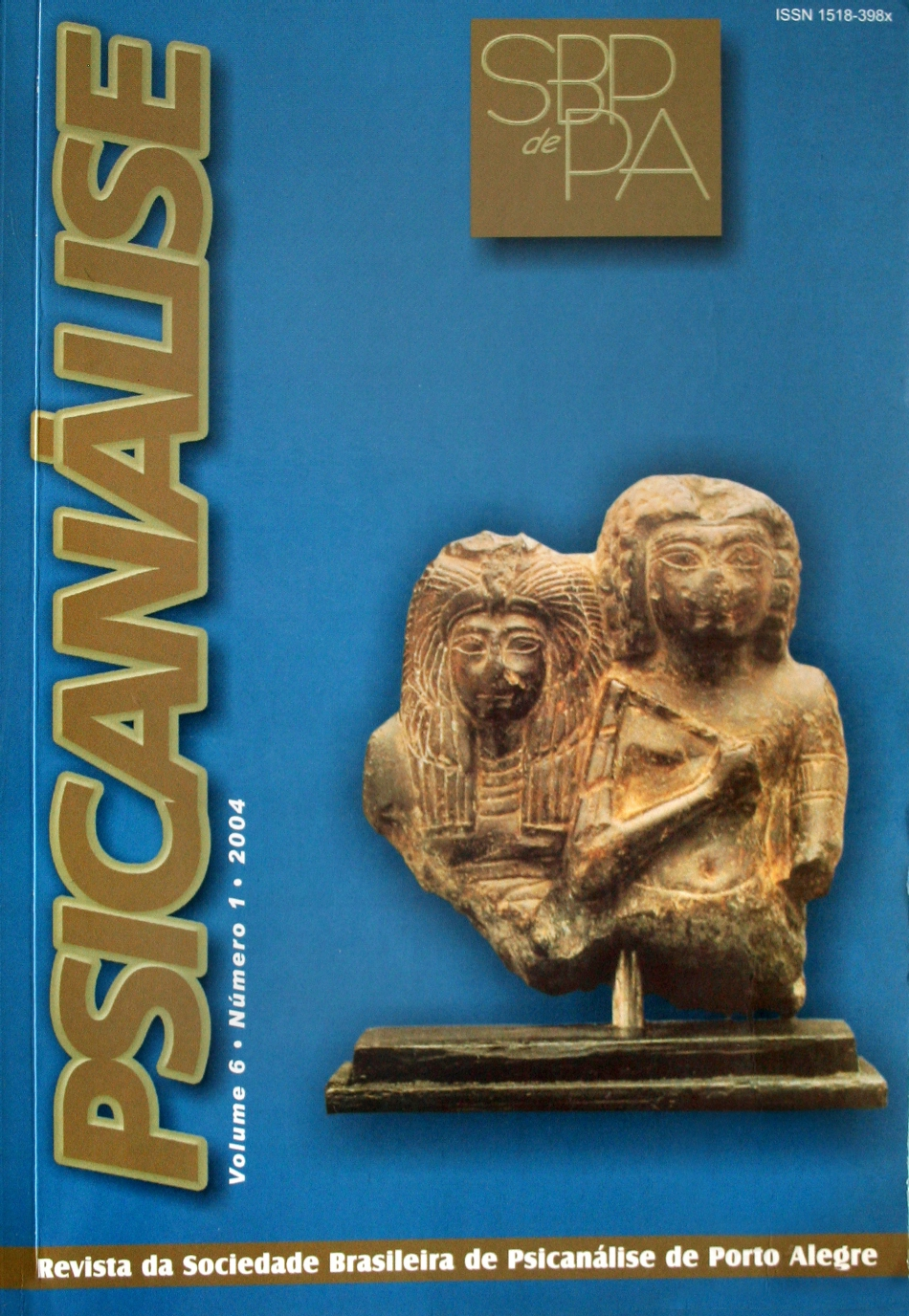Investigação psicanalítica contemporânea
DOI:
https://doi.org/10.60106/rsbppa.v6i1.144Palavras-chave:
Erogeneidade, Linguagem verbal, Investigação, Teoria psicanalítica, EpistemologiaResumo
Os autores pretendem colocar em evidência o valor do Algoritmo David Liberman (um método de estudo da linguagem como expressão da erogeneidade e da defesa) na investigação psicanalítica teórica e clínica. Começam sintetizando o método, que inclui um programa de computador para o estudo das palavras e duas grades, uma para a análise das frases e outra para o estudo dos relatos, todos como expressão da erogeneidade. Na seqüência, examinam questões epistemológicas, sobretudo para salientar o nexo entre o Algoritmo David Liberman (ADL) e as hipóteses metapsicológicas freudianas. A partir dessas considerações, chamam a atenção para uma das linguagens como expressão da erogeneidade: o erotismo oral primário. Essa descrição permite apresentar alguns desenvolvimentos recentes, derivados de investigações de diferentes tipos. Estes desenvolvimentos dizem respeito, por um lado, às características distintivas da retirada narcisista e do restabelecimento do nexo libidinal com o mundo nas caracteriopatias esquizóides e na esquizofrenia. Por outro lado, esses desenvolvimentos se referem àquelas situações em que a retirada narcisista de tais estruturas se mantém e se torna tóxica, conduzindo ao aparecimento de manifestações tóxicas e/ou traumatofílicas. Por fim, esses desenvolvimentos concernem também ao plano teórico, em particular com referência: (1) à eficácia de uma erogeneidade não figurada na linguagem e que, no entanto, é possível inferir; (2) à claudicação prematura (ou ao não desprendimento) do processo alucinatório, na infância precoce; e (3) ao valor dos erotismos sádico-oral secundário e intra-somático, este último expressado nos vínculos de apego. Os autores finalizam, enfatizando a utilidade do ADL como método de investigação teórica e clínica na psicanálise contemporânea.
Downloads
Referências
ALMASIA, A. (2001). Estudio exploratorio del lenguaje en sujetos con apego a Internet. Universidad de Ciencias Empresariales y Sociales. (Tesis de la Maestría de Problemas y Patologías del Desvalimiento)
BION, W.R. (1962). Aprendiendo de la experiencia. Barcelona: Paidós, 1997.
FREUD, S. (1905d). Tres ensayos de teoría sexual. In:______. A.E. V.7.
______. (1914a). Acerca del fausse reconnaissance (‘déjà reconté’) en el curso del trabajo psicoanalítico. In:______. A.E., v.13.
______. (1914c). Introducción del narcisismo. In:______. A.E. v . 14.
______. (1915c). Pulsiones y destinos de pulsión. In:______. A.E. v. 14.
______. (1915e). Lo inconciente. In:______. A.E. v.14.
______. (1920g). Más allá del principio del placer. In:______. A.E. v.18.
______. (1922b). Sobre algunos mecanismos neuróticos en los celos, la paranoia y la homosexualidad. In:______. A.E. v.18.
______. (1923b). El yo y el ello. In:______. A.E. v.19.
______. (1930a). El malestar en la cultura. In:______. A.E. v.21.
______. (1931b). Sobre la sexualidad femenina. In:______. A.E. v. 21.
______. (1950a). Los orígenes del psicoanálisis. In:______. A.E., v.1.
GREEN, A. (1972). De locuras privadas. Buenos Aires: Amorrortu Editores, 1990. GRUPO m (1970). Rhétorique générale. Paris: Larousse.
LACAN, J. (1964). Los cuatro conceptos fundamentales del psicoanálisis. Barcelona: Barral, 1974.
LIBERMAN, D. (1970). Lingüística, interacción comunicativa y proceso psicoanalítico. Buenos Aires: Galerna-Nueva Visión, 1971-72.
MALDAVSKY, D. (1968). Las crisis en la narrativa de Roberto Arlt: algunas contribuciones de las ciencias humanas a la comprensión de la literatura. Buenos Aires: Editorial Escuela, 1968.
______. (1976). Teoría de las representaciones. Buenos Aires: Nueva Visión, 1977.
______. (1980). El complejo de Edipo positivo: constitución y transformaciones. Buenos Aires: Amorrortu, 1982.
______. (1986). Estructuras narcisistas: constitución y transformaciones. Buenos Aires: Amorrortu, 1988.
______. (1990). Procesos y estructuras vinculares. Buenos Aires: Nueva Visión, 1991.
______. (1991). Anorexia en la infancia: metapsicología y clínica. Diarios Clínicos, n. 3.
______. (1992). Teoría y clínica de los procesos tóxicos. Buenos Aires: Amorrortu, 1992.
______. (1993). Judeidad: modalidades subjetivas. Buenos Aires: Nueva Visión, 1993.
______. (1995a). Pesadillas en vigilia: sobre neurosis tóxicas y traumáticas. Buenos Aires: Amorrortu, 1996.
______. (1995b). Linajes abúlicos. Buenos Aires: Paidós, 1996.
______. (1997). Sobre las ciencias de la subjetividad. Buenos Aires: Nueva Visión, 1997.
______. (1998a). Casos atípicos: cuerpos marcados por delirios y números. Buenos Aires: Amorrortu, 1999
______. (1998b). Lenguajes del erotismo. Buenos Aires: Nueva Visión, 1999.
______. (1999). Lenguaje, pulsiones, defensas. Buenos Aires: Nueva Visión, 2000.
MALDAVSKY, D.; BODNI, O.; CUSIEN, I.; ROITMAN, C.; TAMBURI, E.; TARRAB DE SUCARI, E.; TATE DE STANLEY, C.; TRUSCELLO DE MANSON, M. (2000). Investigaciones en procesos psicoanalíticos: teoría y método – secuencias narrativas. Buenos Aires: Nueva Visión, 2001.
MALDAVSKY, D.; COSTA, G.; KATZ, G.; DE OLIVEIRA, F. (2001). La teoría, el método y la investigación psicoanalítica contemporánea. Inédito
SAMI Ali (1990). El cuerpo, el espacio y el tiempo. Buenos Aires: Amorrortu, 1993.
SPITZ, R. (1955). The primal cavity. The Psychoanalytic Study of the Child. New York: International Universities Press, 10.
WIDLÖCHER, D. (2000). Sexualité infantile et attachement. Paris: PUF.
WINNICOTT, D.W. (1971). Realidad y juego. Buenos Aires: Granica, 1972.
Downloads
Publicado
Como Citar
Edição
Seção
Licença
Atribuo os direitos autorais que pertencem a mim, sobre o presente trabalho, à SBPdePA, que poderá utilizá-lo e publicá-lo pelos meios que julgar apropriados, inclusive na Internet ou em qualquer outro processamento de computador.
















